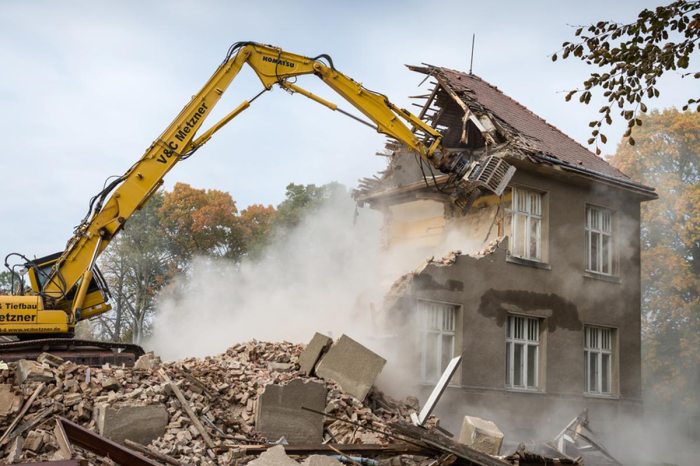Factors Affecting Home Demolition and Rebuilding Cost: What You Need to Know

Delving into the realm of home demolition and rebuilding cost, this article sheds light on the key factors influencing these expenses. From the size and age of the home to the materials used and permits required, every aspect plays a crucial role in determining the overall cost.
Let's explore the intricacies of home demolition and rebuilding costs together.
Factors affecting home demolition and rebuilding cost

When it comes to the cost of home demolition and rebuilding, several factors play a crucial role in determining the overall expenses. Understanding these factors can help homeowners budget effectively and plan for a successful renovation project.
Size and Age of the Home
The size and age of the home are significant determinants of the demolition and rebuilding cost. Larger homes require more materials and labor, leading to higher expenses. Older homes may have structural issues that need to be addressed before rebuilding, adding to the overall cost.
Materials Used
The materials used in the demolition and rebuilding process can greatly impact the cost. High-quality materials tend to be more expensive but can result in a more durable and aesthetically pleasing end result. On the other hand, opting for cheaper materials may lower the initial cost but could lead to higher maintenance expenses in the long run.
Location and Permits
The location of the home and the required permits can also affect the cost of demolition and rebuilding. Homes in urban areas or neighborhoods with strict regulations may face higher permit fees and additional requirements, increasing the overall expenses. Additionally, accessibility to the site and transportation of materials can impact labor costs.
Environmental Considerations, Labor Costs, and Disposal Fees
Environmental considerations, such as hazardous materials removal or eco-friendly building practices, can add to the overall cost of demolition and rebuilding. Labor costs vary depending on the expertise of the workers and the complexity of the project. Disposal fees for debris and waste materials also contribute to the total expenses, especially if specialized disposal methods are required.
Cost breakdown of home demolition and rebuilding
When it comes to demolishing and rebuilding a home, there are several costs involved that need to be considered. From the initial demolition process to the rebuilding phase, each step comes with its own set of expenses. Let's break down the costs involved in this process.
Demolition Costs
- Site Preparation: This includes clearing the area around the home, disconnecting utilities, and ensuring a safe working environment for the demolition crew.
- Labor: Hiring skilled workers to carry out the demolition process safely and efficiently.
- Equipment Rental: Renting machinery such as excavators, bulldozers, and dump trucks for the demolition work.
- Waste Disposal: Proper disposal of debris and hazardous materials generated during the demolition process.
Rebuilding Costs
- Materials: Purchasing construction materials such as lumber, concrete, roofing, siding, and insulation for the rebuilding phase.
- Labor: Hiring contractors, carpenters, electricians, plumbers, and other skilled workers for the construction work.
- Permits: Obtaining necessary permits from local authorities for the construction and rebuilding of the home.
- Finishing Touches: Adding finishing touches such as flooring, paint, fixtures, and landscaping to complete the home.
Tips for reducing home demolition and rebuilding costs
When it comes to demolishing and rebuilding a home, there are several strategies homeowners can implement to reduce costs and stay within budget. From salvaging materials to negotiating with contractors, here are some tips to help lower expenses and make the process more affordable.
Salvaging materials
One effective way to cut down on demolition and rebuilding costs is by salvaging materials from the existing structure. Items like doors, windows, fixtures, and even lumber can be reused or repurposed in the new construction, saving money on purchasing brand new materials.
By carefully deconstructing the home and identifying salvageable items, homeowners can significantly reduce their expenses
DIY demolition tasks
Another cost-saving strategy is to take on some of the demolition tasks as do-it-yourself projects. Simple tasks like removing fixtures, cabinets, or flooring can be tackled by homeowners themselves, eliminating the need to hire professionals for every aspect of the demolition process.
However, it's important to prioritize safety and consult with experts before attempting any major demolition work.
Negotiating with contractors
Homeowners can also reduce costs by negotiating with contractors for better pricing. By obtaining multiple quotes and comparing offers from different contractors, homeowners can leverage competitive pricing to secure a more affordable deal. Additionally, discussing payment plans, project timelines, and cost-saving measures with contractors can help tailor the project to fit within the budget.
Cost-effective building materials and energy-efficient upgrades
Opting for cost-effective building materials and energy-efficient upgrades can also help lower overall expenses. Materials like recycled wood, energy-efficient windows, and eco-friendly insulation can reduce long-term maintenance costs and lower utility bills. By investing in sustainable and energy-efficient features, homeowners can save money in the long run while also reducing their environmental impact.
Recycling options
Lastly, exploring recycling options for construction waste can further reduce demolition and rebuilding costs. Instead of sending debris to a landfill, homeowners can work with recycling facilities to repurpose materials like concrete, metal, and wood. This not only reduces disposal costs but also contributes to a more sustainable construction process.
Comparing different methods of home demolition and rebuilding

When it comes to home demolition and rebuilding, there are various methods that can be employed. In this section, we will compare and contrast traditional demolition methods with newer, more eco-friendly approaches, discussing the pros and cons of each in terms of cost and environmental impact.
Traditional Demolition Methods
Traditional demolition methods typically involve using heavy machinery such as excavators and bulldozers to tear down the structure. While this method may be quick and relatively cost-effective, it often results in a large amount of waste that ends up in landfills.
Newer, Eco-Friendly Approaches
On the other hand, newer, more eco-friendly approaches like deconstruction focus on salvaging and recycling materials from the home. This method is slower and may be more labor-intensive, but it can significantly reduce waste and have a lower environmental impact.
Comparison of Methods
- Deconstruction:Pros include reduced environmental impact, material recycling, and potential cost savings from salvaged materials. Cons may include higher labor costs and longer project duration.
- Implosion:Pros include speed and efficiency in demolition. However, cons may include higher costs and potential safety risks.
- Mechanical Demolition:Pros include cost-effectiveness and quick completion. Cons may include environmental concerns and waste generation.
Case Studies
For example, a home demolition project in a densely populated urban area may opt for implosion due to space constraints and the need for quick completion. On the other hand, a project in a rural area may choose deconstruction to prioritize sustainability and resource conservation.
Conclusion
As we wrap up our discussion on home demolition and rebuilding costs, it's evident that numerous factors come into play when estimating these expenses. By understanding the dynamics of cost breakdowns, tips for reducing expenses, and comparing different methods, homeowners can make informed decisions when embarking on such projects.
Frequently Asked Questions
How can I reduce home demolition and rebuilding costs?
Consider salvaging materials, taking on DIY tasks, and negotiating with contractors for better pricing. Opt for cost-effective building materials and energy-efficient upgrades to lower expenses.
What are some environmental considerations that can impact costs?
Factors like disposal fees and choosing eco-friendly building methods can add to the overall expenses of home demolition and rebuilding.
Is it more cost-effective to opt for traditional or newer demolition methods?
While traditional methods may seem cheaper upfront, newer eco-friendly approaches could prove to be more sustainable in the long run, balancing cost and environmental impact.

